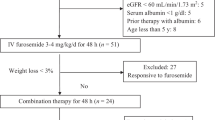Abstract
The contribution of hypoalbuminemia to impaired diuretic responsiveness can be overcome by administering larger doses of loop diuretics. However, the clinical efficacy of the combination of loop-acting diuretics with human albumin remains controversial. In the study reported here, 16 children with nephrotic syndrome and refractory edema were randomized in a cross-over trial to receive either the combination of 20% human albumin and frusemide infusion (HA+FU infusion group) or frusemide infusion alone (FU infusion group). At the end of study, median urine volume was 3.27 [95% confidence interval (CI) 2.04–4.50] ml/kg per hour in the HA+FU infusion group and 1.33 (95% CI 0.79–1.88) ml/kg per hour in the FU infusion group (P = 0.01); the median daily sodium excretion was 58 (95% CI 30–366) mEq and 30 (95% CI 10–122) mEq (P = 0.08), respectively The changes in other variables included weight loss [HA+FU 5.2% (95% CI 3.1–8.8); FU 0.8% (95% CI −1.9 to 4.1); P = 0.006]; urine osmolality [HA+FU 315 (95% CI 220–426) mOsm/kg; FU 368 (95% CI 318–446) mOsm/kg; P = 0.13]; osmolal clearance [HA+FU 1600 (95% CI 916–4140) ml/day; FU 880 (95% CI 510–2105) ml/day; P = 0.01; free water clearance [HA+FU −190 (95% CI −960 to 280) ml/day; FU −162 (95% CI −446 to −70) ml/day; P = 0.18]. The findings from this study suggest that the co-administration of albumin and frusemide infusions is more effective than the administration of frusemide infusion alone in inducing diuresis and natriuresis in patients with nephrotic syndrome.


Similar content being viewed by others
References
Schrier WR, Fasset RG (1998) A critique of the overfill hypothesis of sodium and water retention in nephrotic syndrome. Kidney Int 53:1111–1117
Meltzer JI, Keim HJ, Laragh JH, Sealey JE, Jan KM, Chien S (1979) Nephrotic syndrome: vasoconstriction and hypervolemic types indicated by renin-sodium profiling. Ann Intern Med 92:688–696
Dorhout Mees EJ, Roos CJ, Boer P, Yoe CH, Simatupang TA (1979) Observations of edema formation in the nephrotic syndrome in adults with minimal lesions. Am J Med 647:378–384
Hamm LL, Batuman V (2003) Edema in the nephrotic syndrome: new aspect of an old enigma. J Am Soc Nephrol 14:3288–3289
Koomans HA (2003) Pathophysiology of oedema in idiopathic nephrotic syndrome. Nephrol Dial Transplant 18[Suppl 6]:30–32
Vande Walle JG, Donckerwolcke RA (2001) Pathogenesis of edema formation in the nephrotic syndrome. Pediatr Nephrol 16:283–293
Glassock RJ (1997) Management of intractable edema in nephrotic syndrome. Kidney Inter Suppl 58:S75–759
Elwell RJ, Spencer AP, Eisele G (2003) Combined frusemide and human albumin in the treatment for diuretic-resistant edema. Ann Pharmacother 37:695–700
Haws RM, Baum M (1993) Efficacy of albumin and diuretic therapy in children with nephrotic syndrome. Pediatrics 91:1142–1146
Chalasani N, Gorski JC, Horlander JC, Craven R, Hoen H, Maya J, Brater DC (2001) Effects of albumin/furosemide mixtures on responses to furosemide in hypoalbuminemic patients. J Am Soc Nephrol 12:1010–1016
Wilcox CS (2002) New insights into diuretic use in patients with chronic renal disease. J Am Soc Nephrol 13:798–805
Inoue M, Okajima K, Itoh K, Ando Y, Watanabe N, Yasaka T, Nagase S, Morino Y (1987) Mechanism of furosemide resistance in analbuminemic rats and hypoalbuminemic patients. Kidney Int 32:198–203
Dorhout Mees EJ (1996) Does it make sense to administer albumin to the patient with nephrotic oedema? Nephrol Dial Transplant 11:1224–1226
Davison AM, Lambie AT, Verth AH, Cash JD (1974) Salt poor human albumin in management of nephrotic syndrome. Br Med J 16:481–484
Eadington DW, Plant WD, Winney RJ (1995) Albumin in the nephrotic syndrome. Br Med J 310:1333
Akcicek F (1995) Diuretic effects of frusemide in patients with nephrotic is it potentiated by intravenous albumin? Br Med J 310:102–103
Fliser D, Zurbruggen D (1999) Coadministration of albumin and frusemide in patients with nephrotic syndrome. Kidney Int 55:629–633
Han JS, Na KY (2001) Does albumin preinfusion potentiates diuretic action of frusemide in patients with nephrotic syndrome. J Korean Med Sci 16:448–454
Kim DH (1998) Does albumin infusion enhance the diuretic action of frusemide in nephrotic syndrome? Korean J Nephrol 17:567–573
Bircan Z, Kervancioglu M, Katar S, Vitrinel A (2001) Does albumin and frusemide therapy affect plasma volume in nephrotic children? Pediatr Nephrol 16:497–499
Falkner B, Daniels SR (2004) Summary of the Fourth Report on the diagnosis, evaluation, and treatment of high blood pressure in children and adolescents. Hypertension 44:387–388
Schwartz GJ, Haycock GB, Edelmann CM, Spitzer A (1976) A simple estimate of glomerular filtration rate in children derived from body length and plasma creatinine. Pediatrics 58:259–263
Rabelink TJ, Bijlsma JA, Koomans HA (1993) Isooncotic volume expansion in the nephrotic syndrome. Clin Sci (Lond) 84:627–632
Boer WH, Koomans HA, Dorhout Mees EJ (1987) Renal haemodynamics and sodium handling after hyperoncotic albumin infusion in sodium restricted normal men. Eur J Clin Invest 17:442–447
Vande Walle J, Mauel R, Raes A, Vandekerckhove K, Donckerwolcke R (2004) ARF in children with minimal change nephrotic syndrome may be related to functional changes of the glomerular basal membrane. Am J Kidney Dis 43:399–404
Author information
Authors and Affiliations
Corresponding author
Rights and permissions
About this article
Cite this article
Dharmaraj, R., Hari, P. & Bagga, A. Randomized cross-over trial comparing albumin and frusemide infusions in nephrotic syndrome. Pediatr Nephrol 24, 775–782 (2009). https://doi.org/10.1007/s00467-008-1062-0
Received:
Revised:
Accepted:
Published:
Issue Date:
DOI: https://doi.org/10.1007/s00467-008-1062-0




